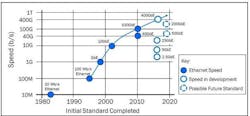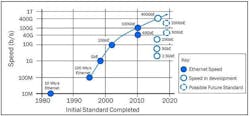A dozen speeds in the Ethernet roadmap
If you knew Ethernet in early 2014 and took a year-long nap like Rip Van Winkle, you might not recognize Ethernet in early 2015. In early 2014, Ethernet consisted of six speeds (10M, 100M, 1G, 10G, 40G, and 100G) and 400 Gigabit Ethernet (GbE) was just starting to be standardized. In early 2015, three new speeds (2.5G, 5G and 25G) are being standardized and 50G and 200G were added to the roadmap.
People used to think of Ethernet as going faster and faster with 10X jumps and expected Terabit Ethernet in the near future. What the industry wants now is lower-cost connectivity that meets their needs for particular applications. To explain how Ethernet is diversifying and expanding into new markets, the Ethernet Alliance has developed the 2015 Ethernet roadmap that includes a dozen speeds as shown in Figure 1.
What's going on here?
The upward rocket-like trajectory of Ethernet has diversified into multiple new speeds and begs for an explanation. The first divergence from the skyward path happened in 2010 when 40GbE was standardized at the same time as 100GbE. Why would anyone want to go slower than the fastest speed available? Don't you want 100GbE instead of 40GbE or even lowly 10GbE?
The answer to what speed you need depends on the application and your budget. When network managers need basic connectivity to hundreds or thousands of devices in a building or across a campus, the budget for the project usually precludes 10GbE to the desktop, so they use GbE. GbE outsells 10GbE by an order of magnitude. Dell'Oro estimates that 279 million GbE switch ports shipped in 2014 compared to 27 million 10GbE ports.1 10GbE is not expected to outship GbE through the end of the decade. Most applications don't need the highest speed; they need the most connectivity they can buy.
One use case shows why users are pushing for 2.5GbE and 5GbE instead of 10GbE. Wireless access points (WAPs) have traditionally been supported by GbE, but the new 802.11ac WAPs can consume multiple gigabits per second and the second wave of 802.11ac can push some WAPs over 5 Gbps. The WAPs often use CAT5E cabling, which is a type of cabling 10GBASE-T doesn't support. To upgrade the hundreds of millions of WAPs to 802.11ac while using existing CAT5E cabling, the industry is producing 2.5GBASE-T and 5GBASE-T. These two new speeds are basically under-clocked versions of 10GBASE-T that can work on the huge installed base of CAT5E.
The Ethernet industry builds off success, and the unexpected success of 40GbE teaches a good lesson that is being duplicated with 25GbE. According to Dell'Oro, over 2 million 40GbE switch ports shipped in 2014, while less than 8,000 100GbE switch port shipped that year.1 The success of 40GbE is mainly attributed to 40GbE being packaged in the low-cost QSFP+ housing and using breakout cables to connect with ubiquitous 10GbE SFP+ ports. Up to 36 QSFP+ ports can be housed in a 1U switch that can be broken out to 144 10GbE ports. The 40GbE QSFP+ supports high volumes of 10GbE ports or 40GbE connections to the network core. 40GbE found a nice application space because it is higher density than 10GbE SFP+ and supports high speed 40GbE links when they are needed to the core.
100GbE and its offspring
100GbE is jumping on the QSFP train by using a new version of the QSFP known as the QSFP28 that can support up to 28 Gbps per lane. Just as 40GbE broke out into four lanes of 10GbE, 100GbE will break out into four lanes of 25GbE in 2015.
The Ethernet switch industry is rallying around the QSFP form factors and the latest SERDES technology that supports lanes up to 28 Gbps. With the cost of 100GbE QSFP28 switch ports dropping rapidly, the uptake of 100GbE should surpass the 1 million ports/year shipment milestone in 2016 according to Dell'Oro.1 That milestone will show that 100GbE has overcome the chicken and egg problem of when volumes will be high enough to drive costs down.
Many people wonder what comes after the 25-28 Gbps SERDES. The answer is likely a 50-56 Gbps SERDES, and these are being defined in both the IEEE P802.3bs 400GbE Task Force and the Optical Internetworking Forum (OIF).
The Ethernet Alliance roadmap predicts that, based on the serial SERDES speeds, it is likely that the next serial step after 25GbE will be 50GbE, and four of those lanes could be placed in a QSFP28 to create 200GbE. The first SERDES running at 50 Gbps have been released, and this implies that 50GbE and 200GbE could be standardized before the end of the decade.
Looking toward 400GbE
The last remaining new speed to discuss then is 400GbE. The main application for 400GbE is in core routers as 100GbE is today. The router market is a much different market than the switch market and sells less than 2 million ports/year2 as compared to over 400 million switch ports/year.1 The router market is driven by speed and is the first place where 10GbE and 100GbE were deployed (and eventually 400GbE will be). Routers use cutting-edge technology that has a different cost sensitivity that most other Ethernet applications.
The possible future 400GbE optical modules are summarized well in this presentation by Jeff Maki of Juniper. Multimode fiber optical modules for 400 Gbps are available today in the CDFP form factor, but the power requirements to support 10-km links favored in routers will exceed the capabilities of the CDFP form factor. The CDFP module supports 16 lanes of 25 Gbps and is excellent for high-speed, proprietary, inter-chassis links, but may be rarely used in Ethernet similarly to how 100GBASE-SR10 has been rarely used. The industry is leaning towards the 8x50-Gbps CFP2 for single-mode applications that are most commonly used in router-to-router or router-to-DWDM links.
Because 400GbE is standardizing the 8x50-Gbps electrical interface, IEEE 802.3bs is trailblazing 50-Gbps technology that will likely be used in 50GbE and 200GbE. The next electrical signaling rate after 50 Gbps lanes is expected to be 100-Gbps lanes, and this flaming hot technology will enable 100GbE SFP+, 400GbE QSFP56, and Terabit Ethernet for routers. The development of the 100GbE SFP+ is an important milestone that the Ethernet Alliance is going to reward with the Holy Grail of 100GbE SFP+ that will be on display at the Ethernet Alliance booth #2531 at OFC. The first company to publicly exhibit a 100GbE SFP+ will be given the beautiful and magnificent Holy Grail.
A look further ahead
The IEEE likely won't define a higher speed than 400GbE in this decade. By 2020, we should see a dozen shipping speeds in the Ethernet armada. The diversification of speeds will lead to refined products that serve particular market needs better. Niche markets in Ethernet, like vehicular Ethernet, should ship hundreds of millions of ports/year by the end of the decade. This rapid introduction of new rates targeting different application areas is just one example of the growing diversity of the Ethernet ecosystem.
The Ethernet Technology Roadmap can be downloaded here. The Ethernet Alliance will unveil its 2015 Ethernet Roadmap at OFC Booth #2531 from March 24-26, 2015.
References
- Dell'Oro Group, "Ethernet Switch Layer 2+3 Report Five Year Forecast 2015-2019."
- "Routers Report Five Year Forecast 2015-2019."
Scott G. Kipp is the president of the Ethernet Alliance. He is also an author and engineer who participates in industry organizations, develops standards and writes books as a senior technologist at Brocade. He is an expert on networking, including protocols, fiber-optic links, and cable management.

